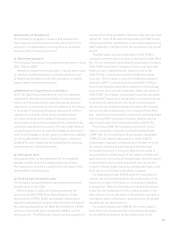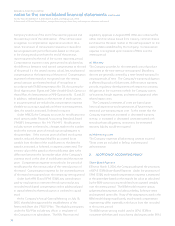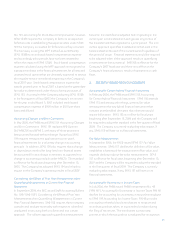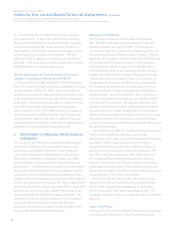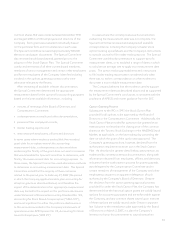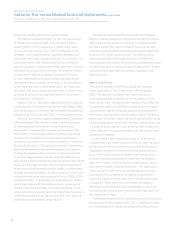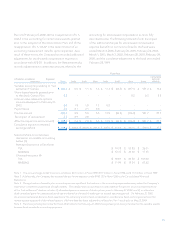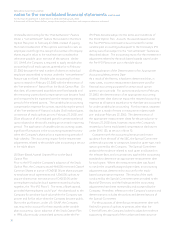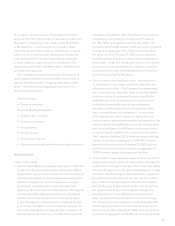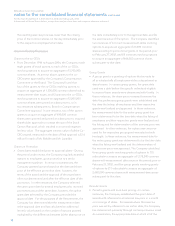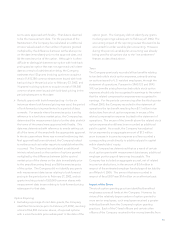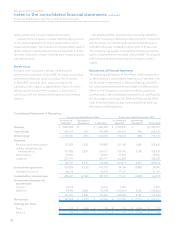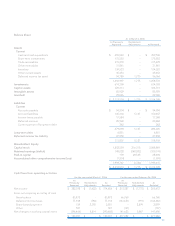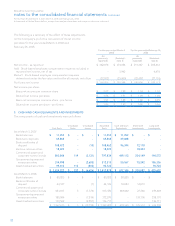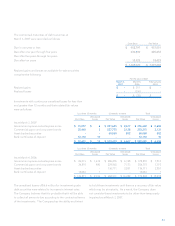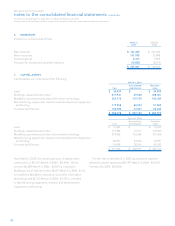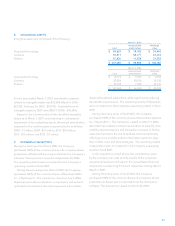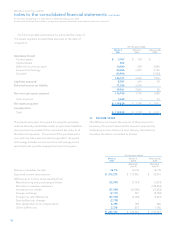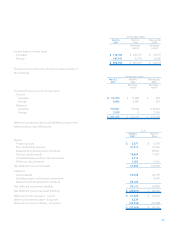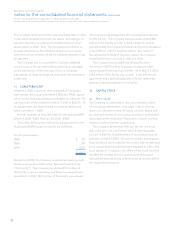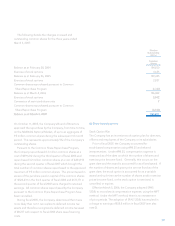Blackberry 2007 Annual Report Download - page 81
Download and view the complete annual report
Please find page 81 of the 2007 Blackberry annual report below. You can navigate through the pages in the report by either clicking on the pages listed below, or by using the keyword search tool below to find specific information within the annual report.79
terms were approved with finality. That date is deemed
to be the measurement date. For the purposes of the
Restatement, the Company has calculated an additional
intrinsic value based on the number of options granted
multiplied by the difference between (a) the share price
on the date immediately prior to the approval date, and
(b) the exercise price of the option. Although it is often
difficult to distinguish between an option with look-back
pricing and an option that was not approved until a later
date as a result of administrative delay, the Company
estimates that 112 grants involving options to acquire a
total of 1,915,380 common shares were issued with look-
back pricing in the period prior to February 27, 2002, and
14 grants involving options to acquire a total of 159,500
common shares were issued with look-back pricing in the
period subsequent to that date.
• Periodic grants with look-forward pricing – In the six
instances where look-forward pricing was used, the period
of look-forward pricing was limited to a period of days
or weeks. For awards where the exercise price is set by
reference to a low future market price, the Company has
determined the measurement date to be the date at which
the terms of the award were approved with finality. This
date was determined with reference to emails setting out
all of the terms of the award with the appropriate approval.
In the six cases where there was no email evidencing that
final approval had been obtained, the Company looked
to evidence such as insider reports to establish when this
occurred. The Company has calculated an additional
intrinsic value based on the number of options granted
multiplied by the difference between (a) the quoted
market price of the shares on the date immediately prior
to the award becoming fixed, and (b) the exercise price
of the option. The Company did not identify any grants
with measurement date issues relating to look-forward
pricing in the period prior to February 27, 2002, and six
grants involving a total of 260,000 common shares with
measurement date issues relating to look-forward pricing
subsequent to that date.
Option Repricing
• Excluding repricings of start date grants, the Company
identified 36 instances prior to February 27, 2002, involving
a total of 166,200 common shares, of repriced options
with a more favorable price subsequent to the date of the
option grant. The Company did not identify any grants
involving repricings subsequent to February 27, 2002, The
accounting impact of the repricing causes the award to be
accounted for under variable plan accounting. However,
during this period, variable plan accounting was already
being used for all options due to the “net settlement”
feature, as described above.
Taxes
The Company previously recorded all tax benefits relating
to tax deductible stock option expenses, primarily arising
on options issued to U.S. resident employees, through the
statement of operations. Pursuant to SFAS 123 and SFAS
109, tax benefits arising from tax deductible stock option
expenses should only be recognized in earnings to the extent
that the related compensation expense was recognized in
earnings. For the periods commencing after the third quarter
of fiscal 2005, the Company recorded in the statement of
operations the tax benefit resulting from $7.3 million in tax
deductions from stock option expenses in excess of the
related compensation expense booked in the statement of
operations. The excess of the benefit above the related stock
option expense should have been recorded as additional
paid-in capital. As a result, the Company has adjusted
its tax expense by an aggregate amount of $7.3 million
as an increase in income tax expense and has recorded a
corresponding credit directly to additional paid-in capital
within shareholders’ equity.
The Company has determined that as a result of certain
stock option grants with measurement date issues, additional
employer portion payroll taxes may be payable. The
Company has included an aggregate accrual, net of related
income tax deductions, in the amount of $3.4 million in
respect of the estimated employer funded payroll tax liability
as of March 4, 2006. The amount that was recorded in
respect of fiscal 2007 was $1.4 million on an after-tax basis.
Impact of the Errors
The stock option granting practices identified benefited
employees across all levels at the Company. However, by
virtue of the relatively larger number of option granted to
more senior employees, such employees received a greater
individual benefit from the Company’s option granting
practices. Each of the C-level officers and certain other
officers of the Company received in-the-money benefits from


